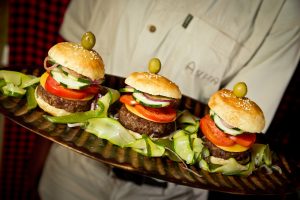Award-winning writer and photographer Stuart Butler always wondered how much work was involved in becoming a safari guide. He got his chance when the acclaimed safari and conservation group Asilia Africa let him be a “fly on the wall” at their wildlife guide training camp in Tanzania’s Tarangire National Park from mid-March until mid-April 2016. Here is the third of his series of dispatches from the time he is spending in the field, which includes interviewing aspiring guides and staff, learning how to track wildlife, and partaking in bush walk training, fly-camping experiences and night safaris.
For the past three weeks I’ve been acting as a ‘mosquito/testse fly on the wall’ at an Asilia Africa guide training camp in northern Tanzania’s Tarangire National Park. For the first week I learnt all about the birds that might be encountered on a safari. In the second week I learnt about ecology, which was very useful because it taught me lots of long, clever-sounding words with which to impress people back home. For this, my third week, I left the brainy people talking about nitrogen cycles and disappeared instead into the kitchens of Asilia’s Olivers Camp to learn all about canapés, food hygiene and blending the perfect pina colada.

Freshly baked cakes (Stuart Butler)
As any of you who have been lucky enough to experience a stay at an Asilia Africa camp will know, lunch, dinner and breakfast are almost as important as lions and giraffes. Every evening guests gather around the campfire and share bush tales over gin and tonics after which elaborate three-course meals are presented with panache. It all seems to run with such gentle ease and organisation that it can be easy to forget that the nearest fresh produce can be many hours’ drive (or even flight) away, and that the chefs and wait staff are using kitchens that, although surprisingly well-equipped considering the locations, are still deep in the bush and lacking in the space and facilities that a top city restaurant will likely enjoy. So how do they do it?
I sat down with head Asilia chef, John De Villiers, who was in camp training the next generation of Asilia chefs, to find out what goes on behind the scenes in an Asilia kitchen. Namibian by birth, John is tall and thin with a sense of humour as dry as his homeland. He now lives a largely nomadic life touring Asilia’s camps across eastern Africa checking and training kitchen staff and putting together new menus. His dry sense of humour and generally meticulous organisational skills probably serve him well as he spends much of his time travelling with Pietro and Lorenzo, the two top wildlife guides at Asilia. Both being Italian, they never miss a chance to remind John (and anyone else) that ‘only’ Italians know how to cook. However, seeing how Pietro coats every meal, including breakfast cereal, in chili sauce both John and I felt that the Italians might have been rather overstating their in-built culinary expertise.

Mini burgers (Stuart Butler)
For a chef working in a city restaurant the day must be rather easy. If you run out of lettuce, you pop down to the market and buy some more. If a kitchen appliance breaks, you race to the shop and buy another. In a safari camp though, that’s rarely the case. John explained to me how all food, drink and cooking supplies have to be ordered days, or even weeks, in advance and that in general only one lorry of supplies per week comes into camp. Even then it’s not uncommon for the lorry to break down or get stuck in a quagmire of thick, black mud, and when that happens some serious culinary improvisation can be called for.
But there was something else about running a bush kitchen that I’d also never before considered. People come to the national parks of Africa to see animals engaged in a never-ending search for food. Animals though aren’t stupid, and many of them quickly learn that easy meals can often be found where humans are present. Indeed, early one morning I found this out for myself when I arrived in the dining tent of Olivers Camp to find a honey badger on top of a table helping himself to coffee and sugar. The name ‘honey badger’ often conjures up an image of a cute little furry creature who, Pooh Bear-like, enjoys nothing more than some honey and toast followed by a snooze in an armchair. Well maybe this honey badger was buzzing on caffeine, but let me tell you there’s nothing cute about these grumpy monsters. Rumour has it that even lions run away from honey badgers. Upon seeing me the badger leapt off the table, and clearly deciding that a half-awake human would make for a tasty snack, came running towards with me with teeth bared and an evil snarl emanating from somewhere in the depths of its throat. I did the manly thing and ran away at top speed screaming like a schoolgirl.

The sundowner – possibly safaris finest moment (Stuart Butler)
John had even bigger tales and he told me how one time, when he was based up at the divine Sayari Camp in the northern fringe of the Serengeti National Park, he and camp manager at the time, Arthur, were sitting talking with guests after dinner when they heard an almighty crash from the kitchen. It was approaching midnight and normally at this late hour the kitchen should be closed up. Arthur and John bravely went to investigate. Trapped inside the kitchen, and busy smashing glasses with abandon, they discovered a wildebeest. A couple of camp guards, who stood forlornly outside wondering what to do, told them that a small herd of wildebeest had been chased through the camp by some lions and whilst the other wildebeest had raced off into the darkness this particular one had decided that the best course of action was to run into the kitchen and try and hide under the table (I think I would be with him on this). John and Arthur set to work trying to rescue the wildebeest. But there was a problem. Not just was the animal large, frightened and potentially dangerous, but the camp guards were all Kuria (a tribal group from northern Tanzania) people, and if there’s one thing the Kuria are renowned for it’s their hunting skills and love of wildebeest meat (there will be another blog post on this topic in the coming weeks). For the camp guards this wasn’t so much an animal in need — it was dinner. It had even taken itself into the kitchen and now needed nothing more than a gentle shove into an oven. After much negotiation with guards who were stunned that John and Arthur were willing to just throw away a good meal the group entered the kitchen in formation, rugby tackled the wildebeest and then manhandled it outside and to its freedom – at least it was free so long as it didn’t bump into the lions…

Breakfast time guests (Stuart Butler)
It wasn’t just John who had stories that would make normal chefs glad they had nothing more serious than a lost tin opener to worry about. Freddy, who works at one of Asilia’s Serengeti camps, told me of baboons stealing all the fruit for breakfast just before it was due to be served and hyenas sneaking into the kitchen and ravaging everything to such an extent that letting a bull into a china shop would seem like a spring clean. Removing the hyenas from their new playground was, in his understated words, “a big problem”.
With honey monsters, hyena and wildebeest dropping by the kitchens every now and then, it’s clear that being a bush tucker chef is no walk in the (national) park. And as my experience with the badger had probably proven if I were ever to find myself working in an Asilia kitchen my role would probably be limited to that of putting cocktail cherries and pink umbrellas in the piña coladas.
Next week I get brave in the bush and learn how to track the big folk during the mammal training course.
To read the intro to the series, click here.
To read part one of the series, click here.
To read part two of the series, click here.

